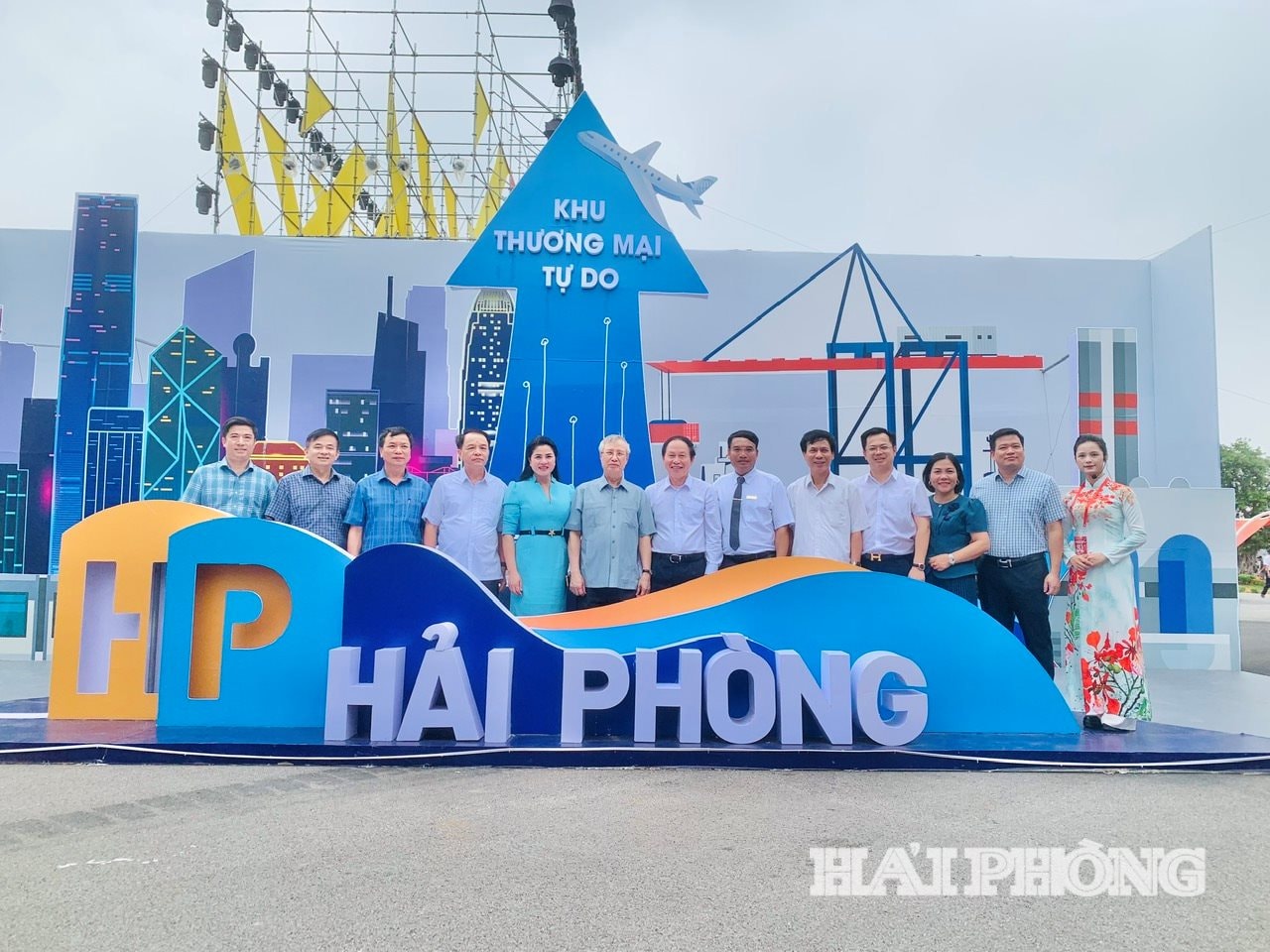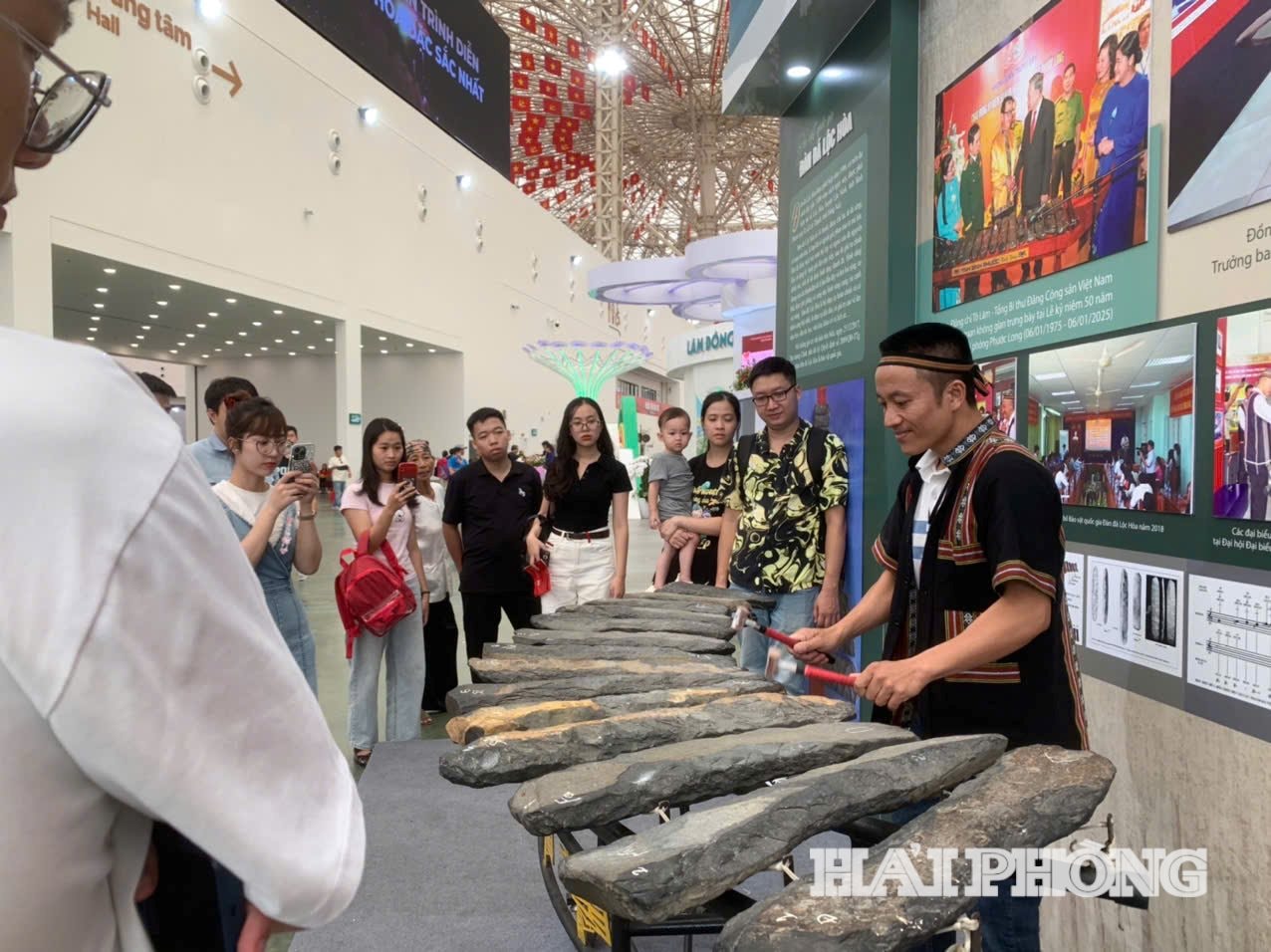
The beauty of 34 provinces and cities
From the moment you step into the National Exhibition Center (Dong Anh, Hanoi), visitors can easily feel the meticulousness in the design and display of the localities. Each booth is like a "cultural card", recreating the socio -economic appearance, history and identity of the land.
The Hai Phong exhibition area made a strong impression with 11 thematic groups, comprehensively reflecting the development journey of the Port City, from "Echoes of Thunder on Route 5", "Hai Phong - Heritage City" to "City of Innovation and Creativity".
Attractive subdivisions such as the overview model and the "future in motion" experience space bring a sense of both closeness and modernity. Nguyen Viet Binh, a student at the People's Police Academy, shared: "It's a wonderful feeling when entering a space filled with the breath of a coastal city." Ms. Do Minh Hang ( Hanoi ) commented: "This is the place to come to see an integrated and strongly developing Hai Phong."

Coming to Dong Nai province, visitors seem to calm down when listening to the sound of Loc Hoa lithophone - a national treasure. Artisan Nguyen Duy Thao performs familiar melodies such as "Echoes of the Country", "The Sound of Pestle on Bom Bo Soc"..., making the sounds from the "inanimate" stones become a bridge connecting the past and the present. "The important thing is that the younger generation continues and preserves this heritage", said artist Nguyen Duy Thao.
Many other spaces also delight visitors: Khanh Hoa with a model of Truong Sa landmark affirming sovereignty over the sea and islands; Ca Mau recreates the southernmost land of the Fatherland with shrimp, crab, and a rich salt industry; Hue ancient capital (Hue city) and Hoi An ancient town (Da Nang) appear as two living heritages in the heart of the exhibition; Ninh Binh introduces the beauty of Trang An - a world heritage; Lam Dong takes viewers to a "highland garden" filled with flowers, tea and ethnic minority culture.
.jpg)
Not just for viewing, many booths also offer direct experiences: pottery making, tea drinking, listening to folk songs, taking photos in traditional costumes. All blend together, turning the exhibition into a "miniature tour" but rich in emotions.
The outdoor area is equally vibrant, from the Thang Long Imperial Citadel (Hanoi) to the youthful city named after Uncle Ho with its myriad of colorful lights. The Hai Phong exhibition space has a dynamic appearance, introducing industry, high-tech agriculture, free trade zones, etc., suggesting a picture of a coastal city on the rise.
Each locality has a growth engine
.jpg)
The special highlight of the 80-year National Achievements Exhibition is the “Rich Province, Strong Country” section, which brings together 34 provinces and cities, demonstrating innovation achievements, cultural identity and development potential. The message is clearly conveyed: when each locality grows stronger from its own strength and identity, the country will develop sustainably and prosperously.
A consistent theme is the presence of technology and innovation. From smart city models, high-tech industrial parks, modern logistics to digital interactive experiences, the exhibition shows an important step forward in development thinking: shifting from breadth to depth, based on science, innovation and added value.
.jpg)
Many localities offer typical models: Hai Phong - a coastal city with breakthrough development, strong integration "reaching out to the sea"; Da Nang is considered the "technology capital of the Central region"; Hanoi aims to become a "global creative city"; Dong Nai with more than 70 industrial parks is transforming into a green and sustainable growth pole. Thai Nguyen with traditional tea trees is upgraded into a modern value chain, applying virtual reality technology for promotion and distribution. Vinh Long introduces a 360-degree tour, taking visitors to explore typical works through digital experiences.
In parallel, the cultural flow is recreated in contemporary language: digitizing relics, demonstrating crafts, integrating AI and AR into cultural experiences. Visitors can “transform” into traditional costumes using technology, or enjoy folk music resounding in a modern space. This is a testament to the effort to turn “static values” into “dynamic experiences”, building local brands from culture.
.jpg)
Some typical highlights: Hanoi's craft village space, Central Highlands gongs, Nghenh Luong Dinh architecture (Hue) becoming a stage for Hue singing performances; Hai Phong's "Red Flamboyant Train"; activities combining digitalization and folk culture performances in Phu Tho. All show a new direction combining culture with economic development.
The exhibition also depicts the trend of inter-regional development and value chain linkage. From highways, logistics corridors, to inter-regional tourism, localities increasingly attach importance to connectivity - not only infrastructure but also the flow of goods, people, ideas, and culture. Lang Son develops cross-border trade associated with the global geopark; Hai Phong connects Hanoi with a cultural-themed railway tourism route; Vinh Long combines experiential tourism with 3D mapping technology...
Overall, the exhibition “80 years of Independence - Freedom - Happiness” has outlined a “dynamic development map” of modern Vietnam. The models not only reflect achievements, but also demonstrate a profound development mindset: innovation associated with identity; economic growth goes hand in hand with human development; rich localities make strong countries, strong countries create the foundation for localities to continue to become rich.
SEA COUNTYSource: https://baohaiphong.vn/di-doc-non-song-tai-trien-lam-80-nam-thanh-tuu-dat-nuoc-520684.html



![[Photo] The 1st Congress of Phu Tho Provincial Party Committee, term 2025-2030](https://vphoto.vietnam.vn/thumb/1200x675/vietnam/resource/IMAGE/2025/9/30/1507da06216649bba8a1ce6251816820)
![[Photo] Solemn opening of the 12th Military Party Congress for the 2025-2030 term](https://vphoto.vietnam.vn/thumb/1200x675/vietnam/resource/IMAGE/2025/9/30/2cd383b3130d41a1a4b5ace0d5eb989d)
![[Photo] General Secretary To Lam receives US Ambassador to Vietnam Marc Knapper](https://vphoto.vietnam.vn/thumb/1200x675/vietnam/resource/IMAGE/2025/9/29/c8fd0761aa184da7814aee57d87c49b3)
![[Photo] General Secretary To Lam, Secretary of the Central Military Commission attends the 12th Party Congress of the Army](https://vphoto.vietnam.vn/thumb/1200x675/vietnam/resource/IMAGE/2025/9/30/9b63aaa37ddb472ead84e3870a8ae825)
































![[Photo] General Secretary To Lam attends the ceremony to celebrate the 80th anniversary of the post and telecommunications sector and the 66th anniversary of the science and technology sector.](https://vphoto.vietnam.vn/thumb/1200x675/vietnam/resource/IMAGE/2025/9/29/8e86b39b8fe44121a2b14a031f4cef46)































































Comment (0)